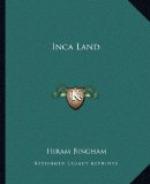The Indians said there were two paths to the outside world. Of one we had already had a taste; the other, they said, was more difficult—a perilous path down the face of a rocky precipice on the other side of the ridge. It was their only means of egress in the wet season, when the bridge over which we had come could not be maintained. I was not surprised to learn that they went away from home only “about once a month.”
Richarte told us that they had been living here four years. It seems probable that, owing to its inaccessibility, the canyon had been unoccupied for several centuries, but with the completion of the new government road settlers began once more to occupy this region. In time somebody clambered up the precipices and found on the slopes of Machu Picchu, at an elevation of 9000 feet above the sea, an abundance of rich soil conveniently situated on artificial terraces, in a fine climate. Here the Indians had finally cleared off some ruins, burned over a few terraces, and planted crops of maize, sweet and white potatoes, sugar cane, beans, peppers, tree tomatoes, and gooseberries. At first they appropriated some of the ancient houses and replaced the roofs of wood and thatch. They found, however, that there were neither springs nor wells near the ancient buildings. An ancient aqueduct which had once brought a tiny stream to the citadel had long since disappeared beneath the forest, filled with earth washed from the upper terraces. So, abandoning the shelter of the ruins, the Indians were now enjoying the convenience of living near some springs in roughly built thatched huts of their own design.
Without the slightest expectation of finding anything more interesting than the stone-faced terraces of which I already had a glimpse, and the ruins of two or three stone houses such as we had encountered at various places on the road between Ollantaytambo and Torontoy, I finally left the cool shade of the pleasant little hut and climbed farther up the ridge and around a slight promontory. Arteaga had “been here once before,” and decided to rest and gossip with Richarte and Alvarez in the hut. They sent a small boy with me as a guide.
Hardly had we rounded the promontory when the character of the stonework began to improve. A flight of beautifully constructed terraces, each two hundred yards long and ten feet high, had then recently rescued from the jungle by the Indians. A forest of large trees had been chopped down and burned over to make a clearing for agricultural purposes. Crossing these terraces, I entered the untouched forest beyond, and suddenly found myself in a maze of beautiful granite houses! They were covered with trees and moss and the growth of centuries, but in the dense shadow, hiding in bamboo thickets and tangled vines, could be seen, here and there, walls of white granite ashlars most carefully cut and exquisitely fitted together. Buildings with windows were frequent. Here at least was a “place far from town and conspicuous for its windows.”




